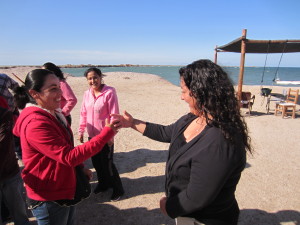How many financial services do you use in your life daily, weekly, annually? Checking accounts, savings accounts, home mortgages, vehicle loans, IRAs, 401ks, stocks, and bonds keep us feeling financially secure. But in rural and isolated communities in Baja California Sur (B.C.S.), Mexico, individuals lack access to even the most basic financial services. Philanthropiece works with these communities in our Community Banks program, teaching them how to form their own savings and loans groups. Fishermen who had to drive four hours to the nearest bank and goat herders who would have spent half of their earnings on bank fees, are both happy and relived to begin saving and accessing reasonable credit for the first time in their lives.
Community Banks serve an essential role in isolated communities, but recently we have seen an interesting trend in this region as new Community Banks have formed in urban areas that already have access to traditional banks. One member of a new bank in the city of Loreto actually has a husband who works at a formal bank, yet she still chooses to save her money in her Community Bank. Why would someone forgo the convenience and security of a formal institution to save their money in a box with a handful of their neighbors? The answer lies in the power of Community Banks to go beyond the financial services they provide. These groups require and reinforce trust and strong relationships in a community.
“This bank is my family,” claimed the woman mentioned above, who is saving in Loreto. Many Community Banks are composed of family members and close friends. Weekly meetings second as social gatherings complete with conversations, food, jokes, and gossip. They are convenient forums where a community can address a challenge, plan an activity, and determine how it uses its resources.
This trust is essential. In countries with less-sophisticated banking systems, people lack confidence in the formal banks, where corruption strangles productivity. Even in the US, people are turning away from big banks in favor of local credit unions, and even community-based savings groups (check out the Northern Lights movement). Most banks in B.C.S, Mexico suffer from chronically long lines – imagine waiting three hours to make a simple withdrawal. Acquiring a loan means wading through a swamp of paperwork and bureaucracy, with the request more than likely to be rejected. Loan sharks provide an alternative, but they demand high interest rates and often collect borrower’s collateral. Community Banks, alternatively, still evaluate loan requests and do charge interest, but decisions are made by the members themselves, and the interest returns to them, not to a loan shark or a bank owner.
Community Banks bring people together while simultaneously serving an important financial need. They educate people on money-management techniques and create opportunities for individuals to invest in their neighbors and friends. Whether rural or urban, a Community Bank can be a recipe for healthy community development, and that’s something we can all consider.
To learn more about the Philanthropiece Community Banks Program in Baja California Sur, Mexico, check out our mini-documentary here.
For a veritable treasure trove of information, stories, impact evaluation, and commentary on the savings group movement, please check out the Savings Revolution website, developed by our friend Paul Rippey and the folks at the SEED Network (Social Economic Environmental Design).


